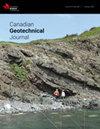基于柱、桩和筏-土界面长期监测的热带红土中桩筏岩土力学性能分析
IF 3.5
3区 工程技术
Q2 ENGINEERING, GEOLOGICAL
引用次数: 0
摘要
本文旨在通过对某53层,高172.4 m高层建筑柱桩应变、筏板-土界面应力和地基沉降的监测,分析和描述该高层建筑桩筏基础的岩土性能。进行了现场和实验室测试,并结合轴对称和三维有限元分析来评估测量数据。对桩应变的监测表明,在开挖完成约6个月后,筏板开挖过程引起的土壤膨胀仍在发生。筏板下不同土剖面的存在,其力学特性不同,影响了基础沉降和桩荷载的分布。最初,平均桩荷载集中在周边元素,但是,随着建筑的发展,它们趋于变得更加均匀。上部结构刚度的影响导致柱中的连续荷载重新分配,这有助于将建筑物的最大角变形维持在允许值内,并减少位于相反土壤剖面的桩之间的荷载差。本文章由计算机程序翻译,如有差异,请以英文原文为准。
Analysis of the Geotechnical Behavior of a Piled Raft in Tropical Lateritic Soil Based on Long-Term Monitoring of Columns, Piles, and Raft-Soil Interface
This paper aims to analyze and describe the geotechnical behavior of a piled raft foundation of a tall building (53 floors, 172.4 m high) through the monitoring of strains in the building’s columns and piles, the stresses at the raft-soil interface, and the foundation settlements. Field and laboratory tests were performed, and associated with axisymmetric and three-dimensional finite element analysis to the assessment of the measured data. The monitoring of the pile strains suggests the occurrence of soil expansion, caused by the raft excavation process, up to approximately six months after the excavation was completed. The presence of different soil profiles under the raft, with different mechanical properties, affected the distribution of the foundation settlements and the pile loads. Initially, the average pile loads were concentrated in the perimeter elements, but, as the construction of the building evolved, they tended to become more uniform. The effect of the superstructure stiffness caused successive load redistributions in the columns, which contributed to the maintenance of the maximum angular distortion of the building within the allowable values and reduced the load difference between the piles positioned in opposite soil profiles.
求助全文
通过发布文献求助,成功后即可免费获取论文全文。
去求助
来源期刊

Canadian Geotechnical Journal
地学-地球科学综合
CiteScore
7.20
自引率
5.60%
发文量
163
审稿时长
7.5 months
期刊介绍:
The Canadian Geotechnical Journal features articles, notes, reviews, and discussions related to new developments in geotechnical and geoenvironmental engineering, and applied sciences. The topics of papers written by researchers and engineers/scientists active in industry include soil and rock mechanics, material properties and fundamental behaviour, site characterization, foundations, excavations, tunnels, dams and embankments, slopes, landslides, geological and rock engineering, ground improvement, hydrogeology and contaminant hydrogeology, geochemistry, waste management, geosynthetics, offshore engineering, ice, frozen ground and northern engineering, risk and reliability applications, and physical and numerical modelling.
Contributions that have practical relevance are preferred, including case records. Purely theoretical contributions are not generally published unless they are on a topic of special interest (like unsaturated soil mechanics or cold regions geotechnics) or they have direct practical value.
 求助内容:
求助内容: 应助结果提醒方式:
应助结果提醒方式:


